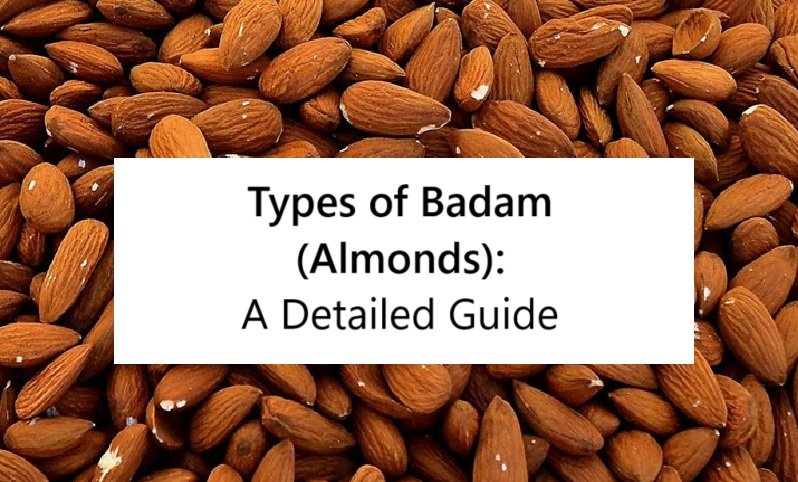
Almonds, commonly known as “badam” in India, are one of the most nutritious and widely consumed nuts worldwide. They are packed with essential nutrients, including healthy fats, proteins, vitamins, and minerals, making them an excellent addition to a balanced diet. Almonds come in various types, categorized based on their origin, processing methods, and taste. In this article, we will explore the different types of almonds and their unique characteristics.
1. Types of Almonds Based on Origin
1.1 Mamra Badam
Mamra almonds are one of the most premium varieties, primarily grown in Iran and Afghanistan. These almonds are known for their high oil content and superior nutritional value.
Characteristics:
- Rich in natural oils (over 50%)
- Crunchy texture with an intense flavor
- Higher protein and nutrient content compared to other varieties
- Usually consumed raw or soaked for better digestion
Health Benefits:
- Improves brain function and memory
- Enhances heart health with good cholesterol (HDL)
- Boosts energy levels due to high oil content
1.2 California Almonds
California almonds are the most commonly available almonds in the market. They are mass-produced and exported worldwide, making them a popular choice for daily consumption.
Characteristics:
- Smooth and uniform in shape
- Lower oil content compared to Mamra almonds
- Available in different forms: whole, sliced, chopped, and flour
- Often used in commercial almond products
Health Benefits:
- Good for weight management due to high fiber content
- Supports heart health with monounsaturated fats
- Helps in maintaining healthy skin due to vitamin E
1.3 Gurbandi Badam
Gurbandi almonds originate from the Himalayan regions of India and Pakistan. These almonds are smaller in size but packed with nutrients and antioxidants.
Characteristics:
- Small and slightly bitter in taste
- High in antioxidants and essential fatty acids
- Rich in omega-3 fatty acids, which are beneficial for brain health
Health Benefits:
- Supports cognitive function and brain development
- Strengthens the immune system
- Aids in improving eyesight due to high vitamin content
1.4 Spanish Almonds
Spanish almonds are well known for their sweet taste and are commonly used in desserts, confectionery, and marzipan.
Characteristics:
- Sweeter than other varieties
- Used in making almond flour, marzipan, and almond milk
- Slightly softer texture compared to California almonds
Health Benefits:
- Provides a quick source of energy
- Enhances skin health with rich vitamin E content
- Supports heart health with healthy fats
2. Types of Almonds Based on Processing
2.1 Raw Almonds
Raw almonds are unprocessed and retain their natural flavor and nutrients. They are often soaked before consumption to remove tannins and improve digestion.
Benefits:
- Best source of natural nutrients
- Helps in better absorption of essential minerals
- Can be used in various recipes, including smoothies and salads
2.2 Blanched Almonds
Blanched almonds are almonds that have had their skins removed by boiling them briefly in hot water.
Benefits:
- Used in baking and cooking
- Easier to digest compared to raw almonds
- Commonly found in almond flour and almond butter
2.3 Roasted Almonds
Roasted almonds are dry-roasted or oil-roasted to enhance their taste and crunch.
Benefits:
- More flavorful than raw almonds
- Great as a snack or for adding crunch to dishes
- Provides a quick energy boost
2.4 Salted Almonds
Salted almonds are roasted almonds that have been seasoned with salt.
Benefits:
- Tasty snack option
- Contains essential minerals like sodium and magnesium
- Must be consumed in moderation to avoid excess sodium intake
2.5 Flavored Almonds
These almonds are coated with different flavors, such as honey, chocolate, or spices.
Benefits:
- Ideal for snacking and gifting
- Provides variety in taste
- Still retains most of the original almond’s nutritional benefits
Conclusion
Almonds are one of the most versatile and nutritious nuts available. Whether you prefer the nutrient-rich Mamra Badam, the widely available California almonds, or the sweet Spanish almonds, there is an almond type for everyone. Additionally, different processing methods, such as roasting, blanching, or flavoring, can enhance their taste and usability. Including almonds in your daily diet can provide numerous health benefits, from improved brain function to better heart health and glowing skin. Choose the type that suits your preference and enjoy the numerous benefits almonds have to offer!
Frequently Asked Questions (FAQs)
1. Which type of almond is best for brain health?
Mamra and Gurbandi almonds are considered the best for brain health due to their high omega-3 fatty acid content.
2. Should I soak almonds before eating?
Yes, soaking almonds overnight removes tannins from the skin and enhances nutrient absorption.
3. Are roasted almonds as healthy as raw almonds?
Dry-roasted almonds retain most nutrients, but oil-roasted almonds may contain added fats, reducing their health benefits.
4. Can I eat almonds daily?
Yes, consuming 5-10 almonds daily is considered beneficial for overall health.
5. What is the difference between Mamra and California almonds?
Mamra almonds have a higher oil content and more nutrients, while California almonds are mass-produced and more affordable.
Enjoy your almonds and stay healthy!



